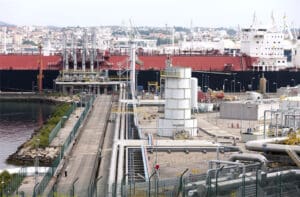After two and a half years of preliminary work, the first large-scale green hydrogen (H2) plant in Galicia began its administrative and environmental processing in May. It includes a production facility implementing electrolysis using water from Lake As Pontes (A Coruña) and new sources of clean energy. The project is supported by Reganosa jointly with EDP Renováveis (EDPR).
Project Details
The hydrogen processing terminal comes in stages of 20, 30, and 50 MW of power, with a plan to reach a capacity of 100 MW once completed. With an annual production capacity of up to 15,873 tons (14,400 tonnes) of H2 for distribution by tanker and injection into a hydro pipeline, the project is expected to prevent the emissions of more than 13,227 equivalent tons (12,000 tonnes) of carbon dioxide (CO2) each month.
At full scale, the complex for the project would require an initial area of 376,736 scf (35,000 m2). Reganosa said its operation and maintenance would generate 50 direct and 55 indirect jobs, 186 professional jobs, and 52 construction jobs. Reganosa said that when it comes to the hiring of workers and suppliers, priority will go to those affected by the cessation of activity in the coal-fired power plant.

This project is part of the Pole for the Transformation of Galicia, articulated by the Xunta de Galicia. Due to its characteristics, the initiative is aligned with the objectives pursued by the European Union (EU) Green Deal and the Next Generation program; the National Energy and Climate Plan, the Spanish Just Transition Strategy, and the Recovery, Transformation and Resilience Plan; and the State Pact for Ferrol, the Law on Administrative Simplification and Support for the Economic Reactivation of Galicia, and the Galician Climate Change Strategy and Energy 2050.
Siemens Energy Joins The Project
Since Reganosa began working on the project at the end of 2019, the development has accumulated 20,000 hours of work in which 30 companies and organizations have been involved in some way. Notable tasks include feasibility studies, market analysis, business strategies, specific digital tools, and conceptual and basic engineering, the latter task for which Inerco’s services have been essential. Siemens Energy has recently joined the project as a technology partner.
Turning Ferrolterra Into The Capital Of Spanish Green Energy
The first large-scale renewable hydrogen plant in Galicia is part of a larger and comprehensive action that EDPR and Reganosa are promoting with the aim of turning Ferrolterra into Spain’s capital of green energy. The plan also includes energy storage consisting of a pumped-storage hydroelectric plant and a wind complex made up of four parks that deploy the latest wind turbine technology and engineering.
Reganosa believes that the strategic alliance of both companies, which integrates the entire hydrogen value chain, is the most ambitious commitment made to date for the decarbonization of the economy in Galicia. If the project is a success, the region will have continuous access to affordable and clean energy, which constitutes a strength for attracting and establishing strategic industries, in addition to promoting the sustainability and competitiveness of the productive fabric.

Green Hydrogen Technology Investments
In addition to the project discussed, Reganosa is also investing in new green hydrogen technologies to help propel it toward a leadership role in Spain’s green hydrogen future. Together with the Technological Institute of Industrial Mathematics (Itmati) and within a consortium of large companies in the sector, Reganosa is developing a digital tool to support the production of H2 through the recovery of waste.
With a budget of US$8.3 million, the Zeppelin consortium will spend between now and the end of 2024 working on innovating efficient and circular technological solutions for the production and storage of green hydrogen. In addition to Reganosa, the consortium is made up of firms from the different links in the H2 value chain: Naturgy, Norvento, Perseo, Redexis, Técnicas Reunidas, Repsol, and Aqualia. Also included in this alliance are the Technological Center for Multisectoral Research (Cetim), coordinator of the project’s technical office, and seven other highly specialized research organizations Cidaut, Ciemat, EnergyLab, Imdea Energía, ITQ, the chemical engineering and technology team of the environment of the University of Valladolid, and the Itmati, integrated in the Center for Research and Mathematical Technology of Galicia (Citmaga).
The consortium has established objectives including researching a set of new green hydrogen production technologies that are alternatives to electrolysis that promote the circular economy through the recovery of waste and byproducts from different sectors such as agri-food, textiles, refineries, water purification, and others. New H2 storage materials and modeling tools for the different technologies will also be developed. The entire budget is aligned with the objective of reducing the energy, economic, and environmental costs associated with the current production of hydrogen, and promoting safe, efficient, and clean energy.

Spain’s Green Hydrogen Focus
According to Reganosa, only 1% of the H2 produced in the world comes from renewable sources, a percentage that the Spanish Hydrogen Roadmap wants to raise to 25% by 2030 to support industrial consumption. Reganosa said that research supports the target that by 2030, green H2 will begin to drive trains, airplanes, and other vehicles.

Hydrogen production using Zeppelin technologies could offer Spain a potential annual generation of circular green H2 of around 148,812 tons (135,000 tonnes), enough for Spanish industry to meet the objectives set out in its green hydrogen roadmap or to meet the energy needs of the entire Spanish railway network. In addition, it will contribute to the policies and objectives in the field of the circular economy by revaluing more than 109.1 million tons (99 million tonnes) of waste and 55.1 million tons (50 million tonnes) of municipal wastewater.
From a socio-economic point of view, Reganosa hopes that Zeppelin will not only provide new technological tools to the energy and mobility sector. It will also encourage economic activity and qualified employment in rural areas. In these places, it could create new market niches by revaluing waste inked to the primary and food sectors as raw material for the energy sector.

















